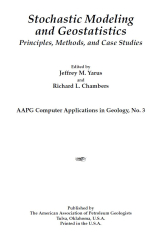Добрый день, Коллеги. Важное сообщение, просьба принять участие. Музей Ферсмана ищет помощь для реставрационных работ в помещении. Подробности по ссылке
Stochastic modeling and geostatistics. Principles, methods and case studies / Стохастическое моделирование и геостатистика. Принципы, методы и тематические исследования
In the fall of 1988 the Society of Petroleum Engineers (SPE) held a forum on reservoir characterization in Grindenwald, Switzerland. Many of the authors who have contributed to this volume were at that forum discussing their ideas on stochastic methods for reservoir characterization. All of these ideas were then still quite new and largely untested; indeed, some of them had not been reduced to practice, but were merely the wild imaginings of creative and curious minds. At that time, there was still a fair bit of controversy over whether stochastic methods had any relevance to the practice of modeling petroleum reservoirs.*
It is a testament to the practical value of stochastic methods that three years later when the SPE held its next forum on reservoir characterization in Crested Butte, Colorado, all of the specific methodologies presented at the Grindenwald forum had found their way into practice through case studies on actual reservoirs. The controversy at the Crested Butte forum was no longer whether stochastic methods should be used, but which ones should be used.
Geologists, geophysicists, and reservoir engineers who observed this explosion in the use of stochastic methods now have a choice of several theoretically sound and practically tested approaches. This wide variety of methods is a double-edged sword—though choice entails the ability to be flexible, it also entails the need to make a decision. Choosing a specific approach can be a bewildering and daunting task for
a newcomer to the field of stochastic methods. Technical articles tend to concentrate on the advantages of the author’s method, leaving the disadvantages to be aired by other authors promoting their own favorite methods.
This overview attempts to provide a balanced accounting of the advantages and disadvantages of the more common and practically successful stochastic methods for reservoir characterization. For each method it also presents a brief outline that is not intended to give a complete description of the nutsand-bolts details but rather to provide a skeleton on which to hang the discussion of the pros and cons. <...>




